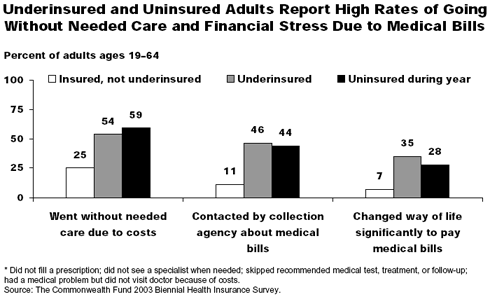In addition to the 45 million uninsured adults in the United States, another 16 million adults were underinsured in 2003, meaning their insurance did not adequately protect them against catastrophic health care expenses, finds a study in Health Affairs. An estimated total of 61 million adults, or 35 percent of individuals, ages 19 to 64, had either no insurance, sporadic coverage, or insurance coverage that exposed them to high health care costs during 2003.
In "Insured But Not Protected: How Many Adults Are Underinsured?" (Health Affairs Web Exclusive, June 14, 2005), The Commonwealth Fund's Cathy Schoen, Michelle M. Doty, Sara R. Collins, and Alyssa L. Holmgren find that inadequate coverage—much like no coverage at all—creates obstacles to care and other burdens. Underinsured adults are almost as likely as the uninsured to go without needed medical care and to incur medical debt. Lower-income and sicker adults are most at risk of having inadequate coverage.
The authors warn that recent market trends will likely place increasing numbers of insured patients and their families at risk, due to higher cost-sharing and out-of-pocket cost exposure. An increase in the numbers of underinsured could undermine effective care, health, and financial security—making it harder to distinguish the uninsured from the insured.
Methods
The extent of the underinsured problem has not been assessed since a 1995 study, partly due to the lack of a working definition. Using a 2003 Commonwealth Fund survey of 3,293 adults, ages 19 to 64, Schoen and colleagues estimated the number of underinsured adults. They define an underinsured person as one who has insurance all year but has inadequate financial protection, as indicated by one of three conditions: 1) annual out-of-pocket medical expenses amount to 10 percent or more of income; 2) among low-income adults (incomes under 200 percent of the federal poverty level), out-of-pocket medical expenses amount to 5 percent or more of income; or 3) health plan deductibles equal or exceed 5 percent of income.
Who Are the Underinsured?
The study finds that 12 percent of adults who were insured all year—nearly 16 million people—were underinsured in 2003. Adults with lower incomes were more likely than those with higher incomes to be underinsured: 73 percent of the underinsured had annual incomes below 200 percent of the federal poverty level. An additional 45 million adults were uninsured either all or part of the year, meaning that a total of 61 million adults were either underinsured or uninsured. Adults with chronic disease or in fair or poor health were at high risk: 43 percent were either uninsured or underinsured.
Access to Care
Relative to those with more adequate insurance, the underinsured were significantly more likely to go without care because of costs. In fact, they reported rates of cost-related, forgone care close to those of the uninsured.
More than one-half of the underinsured (54%) and uninsured (59%) went without needed care during the year: they failed to fill a prescription, skipped a test or follow-up, failed to visit a doctor for a medical problem, and/or did not get specialist care.
Medical Bills
Levels of financial stress among the underinsured rivaled levels among the uninsured and were four times the rates observed among the more adequately insured. Nearly one-half (46%) of the underinsured were contacted by a collection agency for medical bills and more than one-third (35%) said they had to change their way of life to pay medical bills.
Double Jeopardy
Inadequate coverage left those with health problems in double jeopardy: failing to get needed care and, at the same time, grappling with medical bills. These problems were most acute among adults with low incomes and adults with health problems.
Yet, even after taking into account differences in income, health, age, and other characteristics, the underinsured and uninsured were still significantly more likely to report access concerns and negative care experiences than those with adequate coverage.
Coverage Gaps
Compared with the adequately insured, the underinsured were less likely to have prescription drug coverage, dental coverage, or vision benefits and were more likely to face deductibles of $500 or more. In spite of these gaps in coverage, one-third of the underinsured (37%) had high annual premiums ($1,500 or higher). Nearly one-half (47%) paid premiums that amounted to 5 percent or more of their annual income.
Policy Implications
The study highlights the need for policy attention to insurance design. Current private market policies rarely adjust cost-sharing relative to income. Without policy attention, current trends toward rising cost-sharing will likely mean increasing numbers of underinsured among modest and lower-incomes adult and their families.
Facts and Figures
- An estimated 61 million U.S. adults—35 percent of individuals, ages 19 to 64—had either no insurance, sporadic coverage, or insurance that exposed them to catastrophic medical costs during 2003.
- Half of the underinsured (54%) and uninsured (59%) went without at least one of four needed medical services—double the rate of those with adequate insurance.
- Rates of medical bill stress among the underinsured were almost equal to those reported by the uninsured. For example, 46 percent of underinsured individuals were contacted by a collection agency regarding their medical bills, compared with 44 percent of uninsured individuals.
